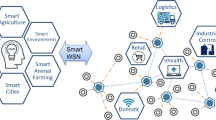Abstract
Node replication attack possess a higher level of threat in wireless sensor networks. A replicated node takes advantage of having legal identity of the compromised node to control the network traffic and inject malicious information into the network. Several techniques have been proposed to detect node replication in wireless sensor networks. However, in most of these techniques, the responsibility for replica detection lies either with the base station or a few randomly selected witness nodes. In this paper, we propose a technique for detecting replicas without the participation of base station and witness nodes. In the proposed scheme, each node is assigned with a color (value), which is unique within its neighborhood. A color conflict within the neighborhood of a node is detected as a replica. We made a comparison of the proposed scheme with RED (Conti et al. in IEEE Trans Dependable Secure Comput 8(5):685–698, 2011), LSM (Parno et al. in Proceedings of IEEE symposium on security and privacy. IEEE, pp 49–63, 2005), and SET (Choi et al. in Proceedings of third international conference on security and privacy in communications networks and the workshops, SecureComm 2007. IEEE, pp 341–350, 2007). Parameters considered for comparison are detection probability, communication complexity and storage overhead. We observed that the proposed scheme has a higher detection probability, and lower communication and storage overhead.






















Similar content being viewed by others
References
Boulis, A. (2011). Castalia 3.2, user’s manual. Australia: National ICT Australia Ltd.
Choi, H., Zhu, S., & Porta, T. F. L. (2007). SET: Detecting node clones in sensor networks. In: Proceedings of third international conference on security and privacy in communications networks and the workshops, SecureComm 2007 (pp. 341–350). IEEE.
Conti, M., Pietro, R. D., Mancini, L. V., & Mei, A. (2011). Distributed detection of clone attacks in wireless sensor networks. IEEE Transactions on Dependable and Secure Computing, 8(5), 685–698.
Ho, J. W., Liu, D., Wright, M., & Das, S. K. (2009). Distributed detection of replica node attacks with group deployment knowledge in wireless sensor networks. Ad Hoc Networks, 7(8), 1476–1488.
Karl, H., & Wilig, A. (2005). Protocols and architectures for wireless sensor netowks. Hoboken: Wiley.
Karlof, C., & Wagner, D. (2003). Secure routing in wireless sensor networks: Attacks and countermeasures. Ad Hoc Networks, 1(2 and 3), 293–315.
Macula, A. J. (1996). A simple construction of d-disjunct matrices with certain constant weights. Discrete Mathematics, 162(1), 311–312.
Parno, B., Perrig, A., & Gligor, V. (2005). Distributed detection of node replication attacks in sensor networks. In Proceedings of IEEE symposium on security and privacy (pp. 49–63). IEEE.
Perrig, A., Stankovic, J., & Wagner, D. (2004). Security in wireless sensor networks. Communications of the ACM, 47(6), 53–57.
Sei, Y., & Honiden, S. (2009). Reporter node determination of replicated node detection in wireless sensor networks. In Proceedings of the 3rd international conference on ubiquitous information management and communication, ICUIMC’09 (pp. 566–573). ACM.
Sohraby, K., Minoli, D., & Znati, T. (2007). Wireless sensor networks technology, protocols, and applications. Hoboken: Wiley
Tran, T. D., & Agbinya, J. I. (2010). Early and lightweight distributed detection of node replication attack in sensor networks. In Proceedings of IEEE wireless communications and networking conference (WCNC) (pp. 01–06). IEEE.
Varga, A., & Hornig, R. (2008). An overview of the Omnet++ simulation environment. In Proceedings of 1st international conference on simulation tools and techniques for communications, networks and systems and workshops, SimuTools’08 (pp. 01–10).
Wang, Y., Attebury, G., & Ramamurthy, B. (2006). A survey of security issues in wireless sensor networks. IEEE Communications Surveys and Tutorials, 8(2), 02–23.
Xing, K., Liu, F., Cheng, X., & Du, D. H. (2008). Real-time detection of clone attacks in wireless sensor networks. In Proceedings of the 28th international conference on distributed computing systems, ICDCS’08 (pp. 17–20). IEEE.
Zhu, B., Setia, S., Jajodia, S., Roy, S., & Wang, L. (2010). Localized multicast: Efficient and distributed replica detection in large-scale sensor networks. IEEE Transactions Mobile Computing, 9(7), 913–926.
Znaidi, W., Minier, M., & Ubeda, S. (2009). Hierarchical node replication attacks detection in wireless sensors networks. In Proceedings of IEEE 20th international symposium on personal, indoor and mobile radio communications, 09 (pp. 82–86). IEEE.
Author information
Authors and Affiliations
Corresponding author
Rights and permissions
About this article
Cite this article
Mishra, A.K., Turuk, A.K. Node coloring based replica detection technique in wireless sensor networks. Wireless Netw 20, 2419–2435 (2014). https://doi.org/10.1007/s11276-014-0751-9
Published:
Issue Date:
DOI: https://doi.org/10.1007/s11276-014-0751-9




